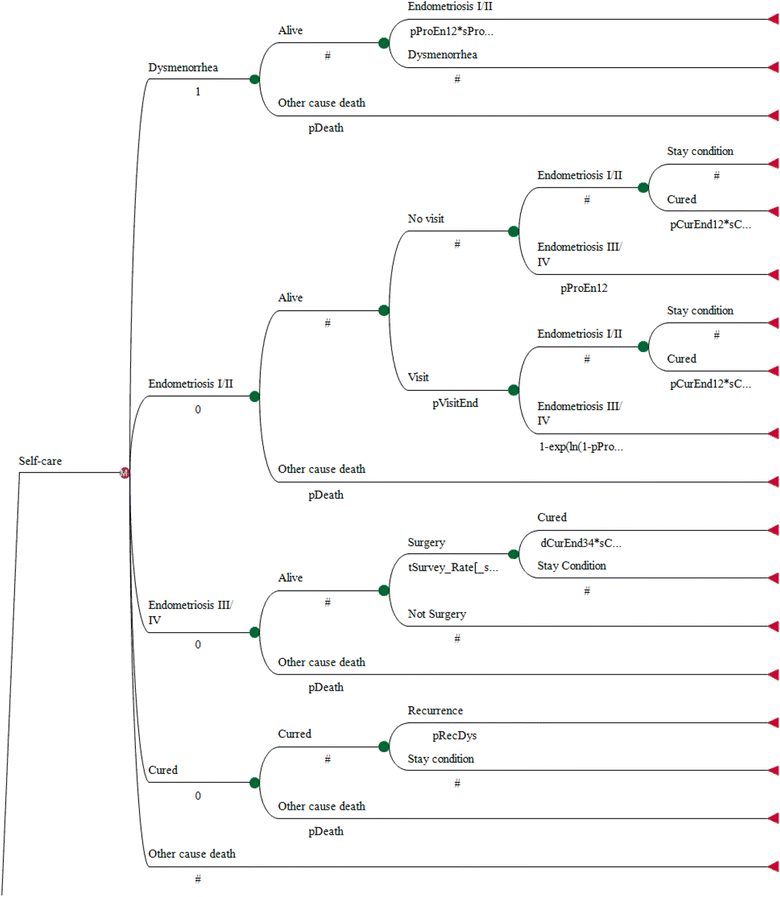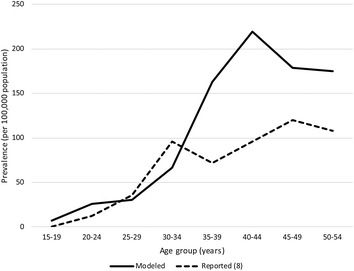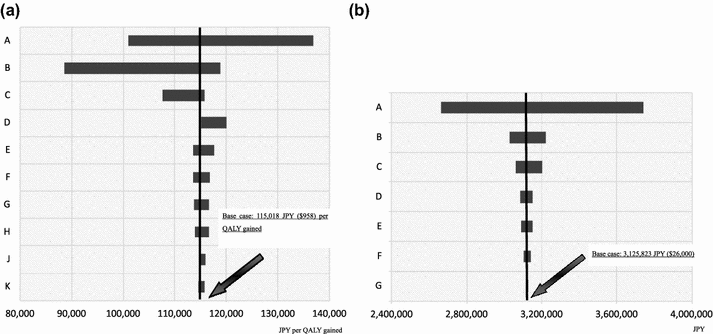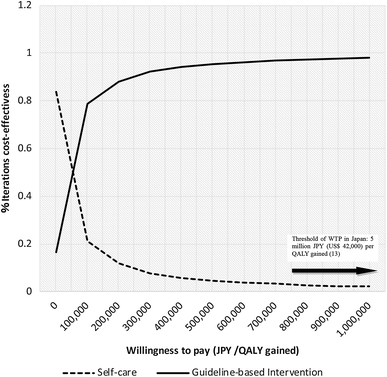Cost-effectiveness of the recommended medical intervention for the treatment of dysmenorrhea and endometriosis in Japan
- PMID: 29643744
- PMCID: PMC5891893
- DOI: 10.1186/s12962-018-0097-8
Cost-effectiveness of the recommended medical intervention for the treatment of dysmenorrhea and endometriosis in Japan
Abstract
Background and objective: This study aims to assess the cost-effectiveness of early physician consultation and guideline-based intervention to prevent endometriosis and/or disease progression using oral contraceptive (OC) and progestin compared to follow-up of self-care for dysmenorrhea in Japan.
Methods: A yearly-transmitted Markov model of five major health states with four sub-medical states was constructed. Transition probabilities among health and medical states were derived from Japanese epidemiological patient surveys and converted to appropriate parameters for inputting into the model. The dysmenorrhea and endometriosis-associated direct costs included inpatient, outpatient visit, surgery, and medication (OC agents, over-the-counter drugs), etc. The utility measure for patients with phase I-IV endometriosis comprised a visual analogue scale. We estimated the cost per quality-adjusted life year (QALY) at a time horizon of 23 years. An annual discount rate at 3% for both cost and outcome was considered.
Results: The base case outcomes indicated that the intervention would be more cost-effective than self-care, as the incremental cost-effectiveness ratio (ICER) yielded 115,000 JPY per QALY gained from the healthcare payers' perspective and the societal monetary value (SMV) was approximately positive 3,130,000 JPY, favoring the intervention in the cost-benefit estimate. A tornado diagram depicting the stochastic sensitivity analysis of the ICER and SMV from both the healthcare payers' and societal perspectives confirmed the robustness of the base case. A probabilistic analysis resulting from 10,000-time Monte Carlo simulations demonstrated efficiency at willingness-to-pay thresholds in more than 90% of the iterations.
Conclusions: The present analysis demonstrated that early physician consultation and guideline-based intervention would be more cost-effective than self-care in preventing endometriosis and/or disease progression for patients with dysmenorrhea in Japan.
Keywords: Cost-effectiveness; Dysmenorrhea; Endometriosis; Guideline-based intervention; Self-care.
Figures




Similar articles
-
A Cost-Effectiveness Analysis of Gemcitabine plus Cisplatin Versus Gemcitabine Alone for Treatment of Advanced Biliary Tract Cancer in Japan.J Gastrointest Cancer. 2017 Dec;48(4):326-332. doi: 10.1007/s12029-016-9885-6. J Gastrointest Cancer. 2017. PMID: 27785685 Free PMC article.
-
Stepwise Approach to the Management of Endometriosis-Related Dysmenorrhea: A Cost-Effectiveness Analysis.Obstet Gynecol. 2021 Oct 1;138(4):557-564. doi: 10.1097/AOG.0000000000004536. Obstet Gynecol. 2021. PMID: 34623067
-
Cost-effectiveness of voretigene neparvovec in the treatment of patients with inherited retinal disease with RPE65 mutation in Switzerland.BMC Health Serv Res. 2022 Jun 28;22(1):837. doi: 10.1186/s12913-022-08211-y. BMC Health Serv Res. 2022. PMID: 35765055 Free PMC article.
-
Multi-gene Pharmacogenomic Testing That Includes Decision-Support Tools to Guide Medication Selection for Major Depression: A Health Technology Assessment.Ont Health Technol Assess Ser. 2021 Aug 12;21(13):1-214. eCollection 2021. Ont Health Technol Assess Ser. 2021. PMID: 34484487 Free PMC article.
-
Is Reconstruction of Unstable Midfoot Charcot Neuroarthropathy Cost Effective from a US Payer's Perspective?Clin Orthop Relat Res. 2020 Dec;478(12):2869-2888. doi: 10.1097/CORR.0000000000001416. Clin Orthop Relat Res. 2020. PMID: 32694315 Free PMC article.
Cited by
-
Pain management and coping strategies for primary dysmenorrhea: A qualitative study among female nursing students.Nurs Open. 2022 Jan;9(1):637-645. doi: 10.1002/nop2.1111. Epub 2021 Oct 30. Nurs Open. 2022. PMID: 34719126 Free PMC article.
-
Use of the visual analogue scale for health state valuation: a scoping review.Qual Life Res. 2023 Oct;32(10):2719-2729. doi: 10.1007/s11136-023-03411-3. Epub 2023 Apr 7. Qual Life Res. 2023. PMID: 37029258 Free PMC article.
-
Prevalence of Primary Dysmenorrhoea and Its Impact on Academic Performance among Croatian Students during the COVID-19 Pandemic.Obstet Gynecol Int. 2023 Jun 3;2023:2953762. doi: 10.1155/2023/2953762. eCollection 2023. Obstet Gynecol Int. 2023. PMID: 37304995 Free PMC article.
-
Clinical practice guidelines for endometriosis in Japan (The 3rd edition).J Obstet Gynaecol Res. 2022 Dec;48(12):2993-3044. doi: 10.1111/jog.15416. Epub 2022 Sep 26. J Obstet Gynaecol Res. 2022. PMID: 36164759 Free PMC article. No abstract available.
-
Type of Dysmenorrhea, Menstrual Characteristics and Symptoms in Nursing Students in Southern Spain.Healthcare (Basel). 2020 Aug 26;8(3):302. doi: 10.3390/healthcare8030302. Healthcare (Basel). 2020. PMID: 32858887 Free PMC article.
References
-
- Taketani Y, Ishimaru T, Hoshiai H, et al. Research on current situation and treatment strategies of endometriosis from viewpoint of reproductive health. Health Sciences Research Grant-in-Aid in 1997. 1998. p. 99–104. https://www.niph.go.jp/wadai/mhlw/ssh_1997_16.htm. Accessed 13 July 2016. (in Japanese).
-
- Guideline on treatment in obstetrics and gynecology. Outpatient visit version 2014. http://www.jsog.or.jp/activity/pdf/gl_fujinka_2014.pdf. Accessed 30 Aug 2016.
LinkOut - more resources
Full Text Sources
Other Literature Sources

